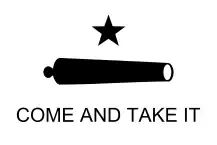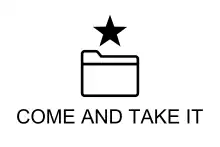Come and take it
"Come and take it" is a historic slogan, first used in 480 BC by Spartan King Leonidas I as a defiant answer and last stand to the surrender demanded by Persian king Xerxes I,[1] and later in 1778 at Fort Morris during the American Revolution, and in 1835 at the Battle of Gonzales during the Texas Revolution.
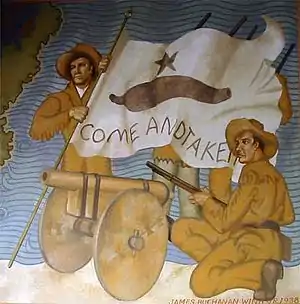
American Revolutionary War
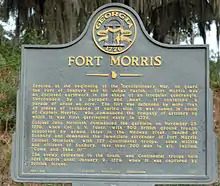
Sunbury, Georgia, is now a ghost town, even though in the pahttp://www.glynngen.com/military/amrev/glynn/mcintoshjno.htm | work = Coastal Georgia Genealogy | title = John McIntosh | publisher = GlynnGen.com }}</ref> The Americans numbered only 127 Continental soldiers plus militiamen and local citizens. The fort itself was crudely constructed and could not have withstood any concerted attack.
The British commander, Colonel Fuser, demanded Fort Morris' surrender through a written note to the American rebels. Though clearly outnumbered (he had only about 200 men plus artillery), Colonel McIntosh's defiant written response to the British demand included the following line: "As to surrendering the fort, receive this laconic reply: COME AND TAKE IT!". The British declined to attack, in large part due to their lack of intelligence regarding other forces in the area. Colonel Fuser believed a recent skirmish in the area, combined with Colonel McIntosh's bravado, might have reflected reinforcements and so the British withdrew.
The British returned in January 1779 with a larger force. They later conquered and controlled nearly all of Georgia for the next few years.[2] Colonel McIntosh's defiance inspired other American rebels as the Revolutionary War moved to the Carolinas and then north.
The Fort Morris Historical Marker is on Martin Road, Midway, Georgia.[3] It is located at the visitor center for the Fort Morris Historic Site. The center is located off Fort Morris Road, at the end of the Colonels Island Highway (Georgia Route 38). The marker memorializes the battle and notes the "Come and Take It!" response.
In recognition of his valor in defending Fort Morris, McIntosh was awarded a sword by the Georgia Legislature with the words "Come and Take It" engraved on the blade.[4] McIntosh later served in the War of 1812 as an American General, still protecting the Georgia coast. He served honorably, receiving honors from the City of Savannah for his service.
Texas Revolution
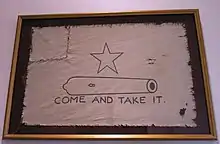

In January of 1831, Green DeWitt wrote to Ramón Músquiz, the top political official of Bexar, and requested armament for defense of the colony of Gonzales. This request was granted by supplying a Spanish made six-pounder bronze cannon on the condition it be returned when asked for, the colony also having a much smaller cast iron cannon of around one pounder calibre. James Tumlinson, Jr. signed for receipt of the six-pounder cannon on March 10, 1831 in Bexar.[5]
At the minor skirmish in 1835 known as the Battle of Gonzales—the first land battle of the Texas Revolution against Mexico—a small group of Texans successfully resisted the Mexican forces who had orders from Colonel Domingo de Ugartechea to seize the loaned cannon after the Texans had refused to return it when asked.
As a symbol of defiance, Caroline Zumwalt and Eveline DeWitt, young women from Gonzales, made a flag containing the phrase "come and take it" (Spanish: Ven y tómalo) along with a black star and a representation of the cannon that they had been loaned four years earlier by Mexican officials.[5] This was the same message that was sent to the Mexican government when they told the Texans to comply with the loan condition and return the cannon; the Texan refusal to do so led to the Mexican attempt to regain the cannon using military force.[6]
The original flag was lost shortly after the battle.[5] Conjectural replicas of the original flag can be seen in the Texas State Capitol, the Bob Bullock Texas State History Museum, the Sam Houston State University CJ Center, the University of Texas at El Paso Library, the Marine Military Academy headquarters building, the Hockaday School Hoblitzelle Auditorium, and in Perkins Library at Duke University.
American Civil War
On October 12, 1864, during the Franklin–Nashville campaign, Confederate general J. B. Hood wrote to the Union commander at Resaca, Georgia, demanding an "immediate and unconditional surrender". That officer, Col. Clark R. Weaver, declined the request and concluded his letter of reply, "In my opinion i can hold this post. If you want it, come and take it".[7]
Adapted uses
| Part of a series on |
| Libertarianism in the United States |
|---|
 |
The first-known modified version, from the 1990s, replaces the cannon with an M16 rifle and was displayed at a Bill of Rights rally in Arizona following the announcement by President George H. W. Bush that certain types of firearms and firearms parts would be banned. It was shown at a number of later rallies and campaign events through the late 1990s, and now resides in a private collection.[9]
In 2002, a version of the flag was created which depicted a Barrett .50 BMG Rifle. Other versions have depicted various firearms, and even other objects dear to the hearts of the flag makers. During the 2000 Stanley Cup Finals at least one Dallas Stars fan had created a replica of the flag with the Stanley Cup replacing the cannon; the Stars were the defending champions that year.[10]
Rock musician Ted Nugent recorded and released a track in 2021 entitled "Come and Take It" for his 2022 album Detroit Muscle.[11]
See also
- "La garde meurt mais ne se rend pas" and "Merde!" ("shit", figuratively "go to hell"), historic response of French General Pierre Cambronne to a request to surrender at the Battle of Waterloo (1815)
- "NUTS!", historic response to an offer of surrender from Nazi Germany at the Siege of Bastogne (1944)
- Reply of the Zaporozhian Cossacks, a painting by Ilya Repin depicting the legend of a defiant Cossack response to an Ottoman ultimatum
- "Je vous répondrai par la bouche de mes canons!" ("I will answer you with the mouths of my cannons"), shortened version of Frontenac's historic response at the Battle of Quebec (1690)
- "They shall not pass", historic phrase of military defiance from many encounters
- "Rússkiy voyénniy korábl, idí náhuy" ("Russian warship, go fuck yourself"), response, during the 2022 Russian invasion of Ukraine, by a Ukrainian border guard on Snake Island to demands from the Russian warship Moskva to surrender.
References
- Plutarch. 225D, "Sayings of Spartans", Leonidas, Son of Anasandridas, saying 11. p. – via Perseus Project.
{{cite book}}:|work=ignored (help) - "North Georgia History". Archived from the original on October 10, 2011. Retrieved October 16, 2011.
- "Fort Morris Marker". HMDB. Retrieved April 1, 2020.
- Knight, Lucien Lamar (1914). Georgia's Landmarks, Memorials, and Legends ...: Under the code duello... pp. 500–501.
- Lindley, Thomas Ricks; Woodrick, James (July 31, 2020). "Gonzales Come and Take It Cannon". Handbook of Texas Online. Texas State Historical Association. Archived from the original on February 17, 2023. Retrieved March 3, 2023.
A few days prior to the battle, two young ladies from Gonzales, Caroline Zumwalt and Eveline DeWitt, hastily prepared a flag with an image of a cannon and the words "Come and Take It". This flag was raised above the Gonzales cannon during the battle on October 2, and later carried with the gun toward San Antonio, but was soon lost without a trace.
- "Come and Take It Cannon Exhibit". Gonzalesmemorialmuseum.com. Archived from the original on October 30, 2012. Retrieved April 1, 2020.
- Sherman, W. T. (1985). Hastings, Max (ed.). The Oxford Book of Military Anecdotes. Oxford University Press. p. 279. ISBN 0-19-214107-4.
- "Defense Distributed – Come And Take It 2.0 Patch". August 26, 2018. Retrieved September 18, 2018.
- Treibs, David C. "History of the 1835 Come And Take It Flag" – via comeAndTakeIt.com.
- Creamer, Chris (October 28, 2020). "Dallas Stars Reveal New "Blackout" Third Uniform". sportslogos.net.
- Hartmann, Graham (November 12, 2021). "Ted Nugent Releases Pro-Gun Rallying Cry 'Come and Take It'". loudwire.com.
External links
- Gonzales "come and take it" cannon from the Handbook of Texas Online
- Gonzales Flag as designed in 1835
- Detailed History of the Come And Take It flag. Includes the modernized versions.
